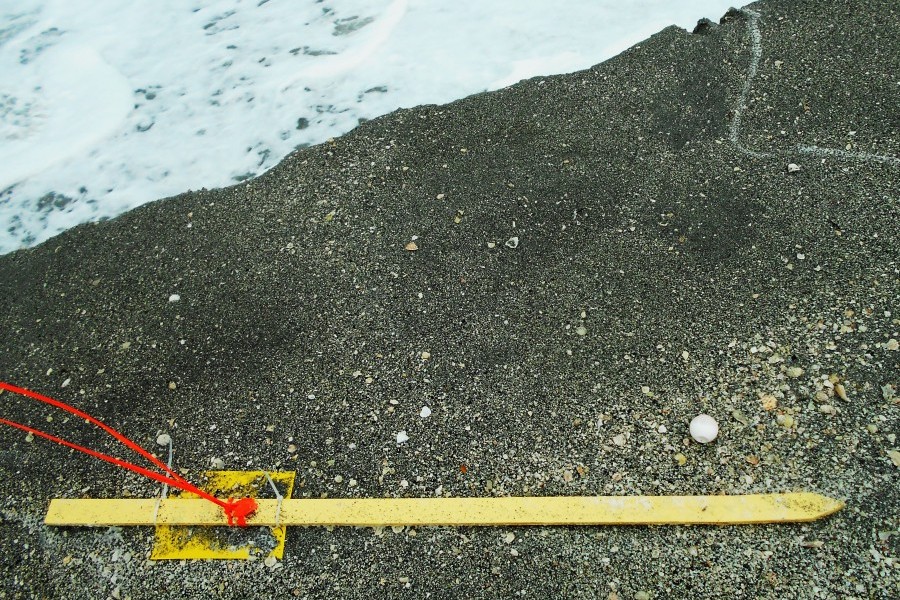Sea turtle nests and storms: Update and tips

Tropical Storm Emily has affected Sea turtle nests from Longboat Key to Venice. Photo credit: Larry Evans/ Mote Marine Lab
Tropical Storm Emily has come and gone, and Mote’s Sea Turtle Conservation & Research Program is currently documenting its impacts on sea turtle nesting on beaches in Mote’s monitoring area, Longboat Key through Venice.
Documenting storm impacts and nesting activity during the storm will likely take more than a week. Mote scientists are documenting which nests are present, re-posting marking stakes if they have been washed away and collecting data about the current status of nests, while continuing their regular monitoring of new nests and hatches.
In a typical year, some nests are washed out by storms or lost to other natural causes. However, each nesting female sea turtle usually lays an average of five to seven nests per season, which helps improve the chances of success. The 2017 nesting season has already brought a record-breaking number of nests to Mote’s monitoring area: 4,315 nests from loggerhead sea turtles and 69 nests from green sea turtles.
Throughout nesting season, May 1-Oct. 31, if you have a question about storm impacts or other issues with sea turtle nests, nesting turtles or hatchlings from Longboat Key through Venice, please call Mote's Sea Turtle Conservation and Research Program at 941-388-4331.
Please don’t interfere with nests that have standing water above them — nests can tolerate being washed over temporarily and are designed to drain. Exposed eggs should be left alone and reported to Mote at 941-388-4331. If nest-marker stakes are in the ground, please leave them alone. If they have been washed out, please place them on the sand, lying down near each other, so Mote’s Sea Turtle Patrol can find them the following morning.
Scientists and volunteers in Mote’s Sea Turtle Patrol monitor nesting activity every day of nesting season along Mote’s 35-mile patrol area from Longboat Key through Venice.
Mote has a Marine Turtle Permit issued by the Florida Fish and Wildlife Conservation Commission (FWC) to work with sea turtles, threatened and endangered species protected by state and federal law. Only those holding appropriate permits may touch or handle sea turtles, their eggs or nest sites. The decision of whether to relocate a sea turtle nest due to storms depends on many factors, and Mote staff are qualified and happy to assess the situation and act in the best interest of sea turtle conservation and in compliance with wildlife regulations.
Aside from natural storm impacts, sea turtles face several human-related challenges during nesting season. Sea turtles and their hatchlings use dim, natural light to find the ocean, and they can become disoriented by artificial lights visible from the beach. Please follow the tips below to keep beaches turtle friendly.
If you find sea turtle hatchlings that are not on the beach or are headed away from the ocean, call Mote’s Sea Turtle Conservation & Research Program for instructions: 941-388-4331. Put rescued hatchlings into a bucket with a layer of sand and cover the bucket with a towel. Do not put hatchlings in water or take them into air conditioning. Hatchlings heading towards the ocean should be left alone. Sea turtles are protected under federal law and any harassment or interference with a sea turtle, living or dead, is subject to penalty.
Here are other turtle-friendly tips:
Do:
- If you encounter a nesting turtle or hatchlings, remain quiet and observe from a distance.
- Shield or turn off outdoor lights that are visible on the beach from May through October.
- Close drapes after dark and stack beach furniture at the dune line or, ideally, remove it from the beach.
- Fill in holes that may entrap hatchlings on their way to the water.
- Vertically stack beach furniture close to the dune line to prevent entanglement.
Do Not:
- Approach nesting turtles or hatchlings, make noise or shine lights at turtles.
- Use flashlights or fishing lamps on the beach.
- Encourage a turtle to move while nesting or pick up hatchlings that have emerged and are heading for the water.
- Use fireworks on the beach.